If you’re looking for an effective way to stabilize the soil on a hillside while also adding beauty to your landscape, a ground cover for hillside may be just what you need. However, before making a purchase, there are some things to consider.
First and foremost, it is important to choose a ground cover that is appropriate for the climate and soil conditions of your hillside. Some ground covers may require full sun, while others may thrive better in shaded areas. Additionally, you should consider the amount of foot traffic the area will receive and whether the ground cover you choose is able to withstand that.
Another factor to consider is the maintenance required for the ground cover. Some may require regular watering or pruning, while others may be self-sufficient. It is important to choose a ground cover that fits within your maintenance abilities and schedule.
Are you tired of constantly battling against erosion on your hillside? Or maybe you’re looking for a way to add some color and texture to your landscape? Whatever your reason for considering a ground cover for hillside, there are many options available to suit your needs. Keep reading to discover the top ground cover options for hillside stability and landscape beauty.
10 Best Ground Cover For Hillside
| # | Product Image | Product Name | Product Notes | Check Price |
|---|---|---|---|---|
|
1
|
This product is ideal for erosion control on hills and slopes, trusted by contractors and homeowners across America.
|
|
||
|
2
|
It is ideal for erosion control, ground cover, lawn alternative, pasture and forage.
|
|
||
|
3
|
This product is ideal for creating a low-maintenance lawn that requires less watering and fertilization.
|
|
||
|
4
|
This plant is ideal for use as Asian ground cover, fully rooted with soil, adding beautiful foliage to your outdoor space.
|
|
||
|
5
|
This product is ideal for landscaping and ground cover with its purple creeping thyme seeds, providing approximately 8000 seeds.
|
|
||
|
6
|
Ideal for providing drought-tolerant ground cover with cold hardy evergreen foliage in large quantities.
|
|
||
|
7
|
Ideal ground cover plant for warm weather climates, low maintenance lawns, and alternative to traditional grass lawns.
|
|
||
|
8
|
This product is ideal for attracting pollinators and providing ground cover in zones 3 and above.
|
|
||
|
9
|
The product is ideal for controlling erosion on landscapes and can be secured with biodegradable staples.
|
|
||
|
10
|
This product is ideal for ground cover between flagstones due to its low-growing and mat-forming qualities.
|
|
1. Ecogrip Erosion Control Netting – 225 Ft Roll
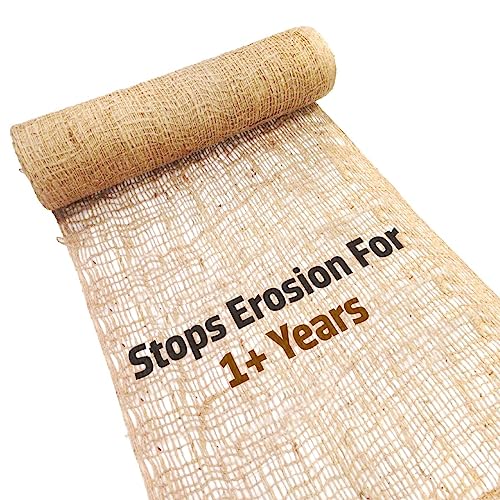
Prevent erosion from damaging your property with Sandbaggy’s Jute Matting. This eco-friendly solution is perfect for those who want to protect the environment while also safeguarding their land. The jute matting is easy to install, simply unroll it down your hillside and secure it with landscape staples. The matting will protect your slope from the harsh winter storms that can cause erosion. The natural jute material used in the matting makes it 100% biodegradable, so you won't have to worry about any clean-up, carbon emissions, or trash in landfills.
Sandbaggy Jute Matting is the number one best-selling erosion control product on the internet. It is made entirely of naturally grown jute plants, and does not use any synthetic materials, which makes it an eco-friendly option for your land. While jute does have a unique smell, it will dissipate after the roll is installed and aired out.
- Eco-friendly solution to prevent erosion
- Easy to install
- Made of 100% naturally grown jute plants
- Naturally biodegradable
- Number one best-selling erosion control product on the internet
- – Jute has a unique smell, but it will dissipate after installation
2. White Dutch Clover: Ultimate Multi-Purpose Seed
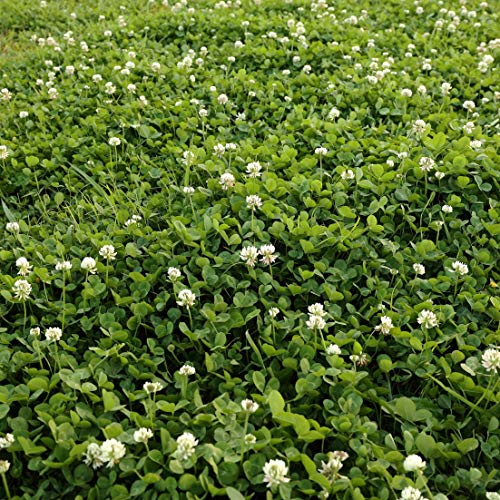
White Dutch Clover Seed is an ideal perennial seed for several applications such as erosion control, lawn alternative, food plots, green manure crop, pasture mixtures, ground cover, and many other uses. It is a versatile seed that can be grown in USDA Zones 3 – 10 for deer food plots, erosion control, pasture mixtures, and cover crops. The seed helps improve soil nitrogen levels by extracting nitrogen from the air and fixing it in the soil. This process boosts soil fertility, and the seed can also be used as a lawn alternative.
The White Dutch Clover Seed is easy to plant, and it can be seeded by broadcasting the seed on the prepared soil and raking it in lightly. It is essential to keep the clover seed continuously moist until germination occurs, which usually takes about 14 days with temperatures of 65 – 70°F. The recommended seeding rate is 1/4 lb – 1/2 lb per 1,000 square feet or 8 to 10 lbs per acre. Planting this seed is an excellent way to address soil erosion, and it also provides a natural source of food for deer and other wildlife. Moreover, it is a low-maintenance option for a green lawn alternative, and it helps to suppress weed growth.
- Improves soil nitrogen levels
- Provides natural food for deer and other wildlife
- Low-maintenance lawn alternative
- Suppresses weed growth
3. Outsidepride Perennial White Miniclover Lawn Clover & Ground Cover Seeds – 5 Lbs, Green
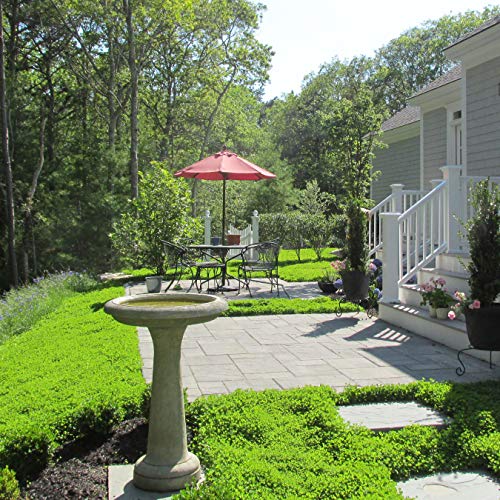
Miniclover is a type of perennial white clover that is used as an alternative to traditional lawns or as a ground cover. It grows to a height of only 4-6 inches after a few mowings and serves as a natural fertilizer because it fixes nitrogen from the air. The seeds of this clover, Trifolium repens, are much better suited for lawns than other white clovers. Additionally, Miniclover is a dwarf variety that only grows to half the height of White Dutch Clover, and its leaf heads are only 1/3 to 1/2 the size.
This microclover is ideal for those who prefer a no-mow lawn. It is a perennial that can be grown in USDA Zones 3-10. Sow 1-2 pounds of clover seeds per 1,000 square feet of lawn for optimal growth.
- Miniclover is a natural fertilizer because it fixes nitrogen from the air
- It is a dwarf variety that only grows to half the height of White Dutch Clover
- This microclover is perfect for those who prefer a no-mow lawn
- It is a perennial that can be grown in USDA Zones 3-10
- – None found.
4. Asiatic Jasmine Minima – 60 Live Plants – Asian Ground Cover Fully Rooted With Soil
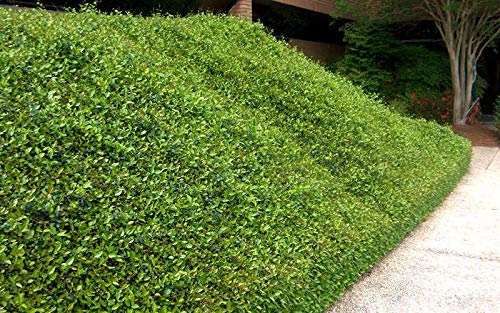
Trachelospermum asiaticum, commonly known as Asiatic Jasmine, is an evergreen, vine-like woody plant that is grown, packaged, and shipped exclusively by Florida Foliage. Originally native to Japan and Korea, this low-maintenance groundcover is widely used in landscapes due to its hardiness and drought tolerance. It is perfect for those who want an attractive garden without much effort. In shady areas, it adds texture and variation to the garden.
Asiatic Jasmine is an ideal plant for mass plantings and turfgrass alternatives. Once established, it requires very little maintenance to keep it looking nice. It suppresses weed growth and can tolerate many growing conditions. It requires little mowing, but occasional trimming of its edges is recommended. The plant should be used in low traffic areas as it does not withstand foot traffic well. It is salt-tolerant and can be grown in coastal areas.
This versatile plant can even be grown in containers and hanging baskets. However, it should be noted that too much water, sun, or fertilizer can make it aggressive and unruly. It is easier to control when neglected.
- Hardy and drought-tolerant
- Low maintenance plant
- Ideal for mass plantings and turfgrass alternatives
- Suppresses weed growth
- Salt-tolerant
- Can be grown in containers and hanging baskets
- – Does not withstand foot traffic well
- – Can become aggressive and unruly with too much water, sun, or fertilizer
5. Purple Thyme – Premium Ground Cover Seeds
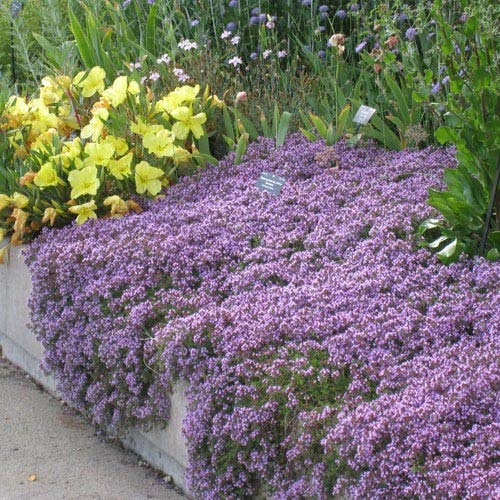
For those looking to add an adaptable ground cover to their landscape, the Creeping Thyme (Thymus Serpyllum) is a great option. This perennial herb is a popular choice for its ability to over-winter well in zones 4-9 and can handle moderate foot traffic. As a dwarf ground cover, it is often used to line flower beds or fill gaps between pavers on walkways.
With a net weight of 0.05 oz, this small packet contains approximately 8,000 tiny seeds that can cover a large area. When planting, it is important to press the seeds into the soil rather than covering them. Ensuring good contact between the seeds and soil will increase germination rates. It is best to sow seeds directly outdoors between May and August when temperatures are consistently in the high 60s or above. Dividing established plantings can also be done in March and April.
This low maintenance ground cover can make an excellent alternative to traditional lawns. However, please be advised that if purchasing from a seller other than Utopia Seeds, you may receive incorrect seeds. Creeping Thyme seeds are very small, so be prepared for a small packet.
- Adaptive, popular and versatile dwarf ground cover
- Can handle moderate foot traffic
- Perennial herb that over-winters well in zones 4-9
- Approximately 8,000 seeds can cover a large area
- Good seed to soil contact increases germination rates
- Can be sowed directly outdoors between May and August
- Established plantings can be divided in March and April
- Low maintenance ground cover
- Excellent alternative to traditional lawns
- – Seeds are very small and come in a small packet
- – Fall plantings should be avoided to protect against freeze damage
- – May receive incorrect seeds if purchasing from a seller other than Utopia Seeds
6. Blue Rug Juniper – 60 Live Plants – Drought Tolerant Cold Hardy Evergreen Ground Cover

The Silver Blue Juniper is a premium trailing juniper with a uniform and full centered growth habit. It boasts intense silver-blue evergreen foliage that adds a touch of elegance to any landscape. This evergreen has a heavy texture with good color retention year-round, and in extremely cold climates, it may exhibit a slight purple cast during winter. However, this quickly changes back to its normal color with the onset of warmer temperatures in spring.
This low-maintenance evergreen is easy to grow and maintain. It requires a regular watering schedule initially to ensure the growth of a mature root system. Once established, it only needs occasional watering, except during drought conditions when regular watering is essential. Pruning is recommended only during the early stages of growth to encourage branching. Pruning older branches may not encourage new growth.
Its versatility makes it an excellent choice as a sprawling ground cover, rock gardens, foundations, retaining wall edges, mass on slopes for erosion control, and rocky ground. This plant is grown, packaged, and shipped exclusively by Florida Foliage, ensuring the highest quality and best value for your money.
- Uniform and full centered growth habit
- Intense silver-blue evergreen foliage
- Heavy texture with good color retention year-round
- Versatile and low-maintenance
- Grown, packaged, and shipped exclusively by Florida Foliage
- – May exhibit a slight purple cast in extremely cold climates during winter
7. Dwarf Dichondra: Lawn Alternative And Ground Cover
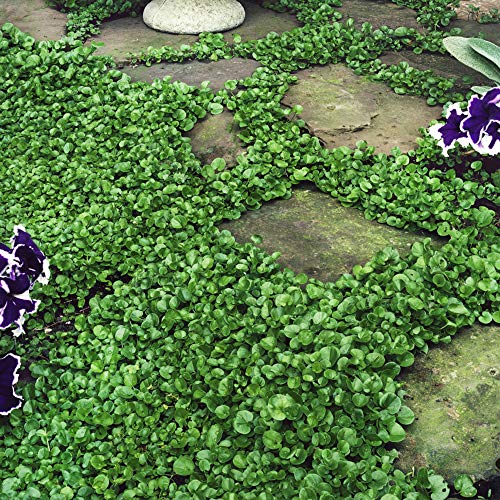
Dichondra repens is an excellent choice for those who want a lawn alternative. This fast-growing ground cover plant is easy to establish from seed, making it a popular choice for landscaping. It has a creeping growth habit with broad, almost circular leaves that give it a bright green color. It grows close to the ground, usually not over 2 inches tall, and has a very good feel underfoot.
This plant is a perennial and is best suited for USDA Zones 7 – 11. It has a prostrate growth habit and is adapted to warmer climates. However, it can retain its striking green color during winter temperatures as low as 20 – 25 degrees Fahrenheit with only slight leaf browning. Dichondra Repens is commonly called Kidney Weed, Dichondra Pony Foot, or Lawn Leaf. It only reaches a maximum height of 2-3 inches and never needs to be mowed, making it a low-maintenance alternative to traditional lawns.
Dichondra Repens is a versatile plant that can be used in many ground cover situations where normal grasses may not do as well. It establishes a thick dense carpet look when mowed low, making it a great choice for landscaping areas of no maintenance. When used in lawn situations, it can be mowed for an even, smooth finish. For the nicest appearance, it is recommended to mow dichondra approximately every two weeks at a height of 1 1/2" – 2" during the summer months and as low as 3/4" during the winter months.
To plant Dichondra Repens, 1 pound of seed per 500 square feet is recommended. These seeds are heirloom and non-GMO, making them a safe and sustainable choice for any garden.
- Easy to establish from seed
- Low-maintenance alternative to traditional lawns
- Versatile plant that can be used in many ground cover situations
- Establishes a thick dense carpet look when mowed low
- Bright green color and a very good feel underfoot
- Heirloom and non-GMO seeds
- – Best suited for warmer climates (USDA Zones 7 – 11)
8. Honey Bee And Butterfly Magnet Ground Cover
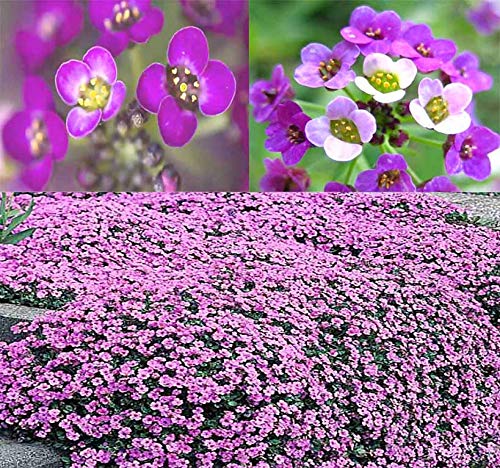
Looking for a flower seed that can attract honey bees, birds, and butterflies? Try the Alyssum Royal Carpet Flower Seeds! This product guarantees high germination rates and contains 100% pure seeds, with no fillers added. It is also suitable for all regions of North America.
The Alyssum Royal Carpet is a great addition to any garden, as it can be used as ground cover. It produces beautiful flowers that can bloom even more profusely if trimmed regularly. It is also known for attracting honey bees, birds, and butterflies, making it a great choice for nature lovers.
To ensure the best results, sow the seeds in well-drained soil and in a location that receives full sun or partial shade. Water the seeds regularly and avoid letting the soil dry out. With proper care, the Alyssum Royal Carpet can grow up to 4-6 inches tall and 6-12 inches wide, and start blooming within 6-8 weeks after sowing.
- 100% pure seeds with no fillers added
- High germination rates guaranteed
- Suitable for all regions of North America
- Attracts honey bees, birds, and butterflies
- Can be used as ground cover
- Produces beautiful flowers that can bloom even more profusely if trimmed regularly
9. Ecoroll: Biodegradable Erosion Blanket With Staples (Brand: American Excelsior, Category: Landscape)
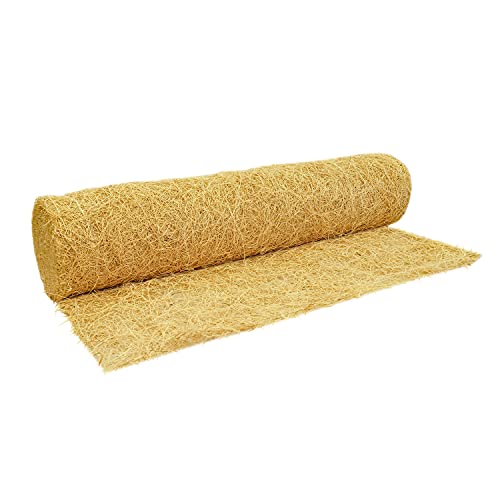
This erosion control blanket is an excellent solution for complying with most storm water management regulations. It is DOT approved and can be easily installed using 20 E-Staples that come included in the package. The blanket can enhance grass seed germination by retaining water, which is especially helpful during dry seasons. However, it does not come with grass seeds. The blanket also protects seeds from birds and the sun's heat, making it ideal for outdoor use. It is degradable and the fibers cling to each other and soil to hold seed and soil in place. The durable single net made of plastic ensures that the blanket remains intact for a long time. This product is made in the USA, ensuring that it meets all quality standards.
- Complies with most storm water management regulations
- DOT approved
- Fast and easy installation with 20 E-Staples included
- Enhances grass seed germination by providing super water retention
- Protects seeds from birds and sun's heat
- Degradable and eco-friendly
- Durable single net made of plastic
- Made in the USA
10. Low Growing Irish Moss Ground Coverage – 10000 Seeds.
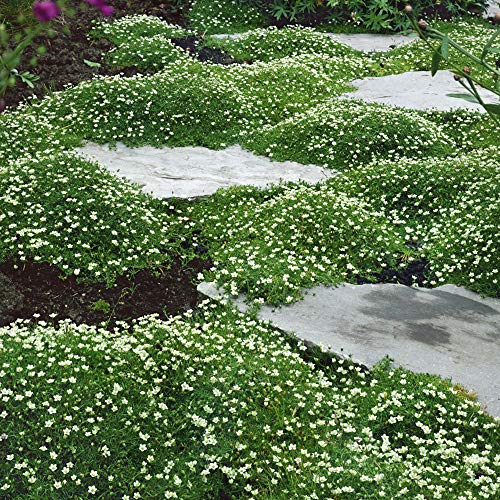
Looking for a versatile and attractive groundcover? Consider Irish moss seed, also known as pearlwort. This plant, scientifically named Sagina Subulata, grows best in areas with full sun or partial shade. During summer, it produces tiny white blooms, adding a touch of beauty to your garden. As one of the few groundcovers that can be used as a lawn alternative or substitute, it's also great to plant in-between stepping stones.
To grow Sagina Subulata, keep the seeds continually moist until germination and plant them in USDA Zones 4 – 10. Once established, this low growing ground cover will only reach a height of 2 – 3 inches. It is Outsidepride's most popular ground cover plant seed, and you will need to sow 5000 seeds to cover 100 square feet. Start growing your own plants today!
- Produces tiny white blooms during summer months
- Versatile groundcover that can be used as a lawn alternative or substitute
- Great to plant in-between stepping stones
- Low growing groundcover that will only reach a height of 2-3 inches
- Outsidepride's most popular ground cover plant seed
Best Ground Cover For Hillside FAQs
Are there any native ground covers that are well-suited for a hillside environment?
Yes, there are several native ground covers that are well-suited for a hillside environment. One of the most popular options is creeping phlox, which is a low-growing plant that spreads quickly and produces beautiful flowers in shades of pink, white, and purple. Another great option is moss, which can create a lush, green carpet that helps prevent erosion and retains moisture in the soil. Other native ground covers that are suitable for hillside environments include wild ginger, foamflower, and barren strawberry. Each of these plants has unique characteristics that make them ideal for hillside environments, such as their ability to thrive in rocky or sandy soil and their tolerance for drought and extreme temperatures. When selecting a native ground cover for a hillside, it's important to consider the specific conditions of the site, such as the amount of sunlight and moisture available, in order to choose a plant that will thrive in that environment.
Can ground covers help prevent erosion on a hillside?
Yes, ground covers can definitely help prevent erosion on a hillside. Ground covers are plants that grow low to the ground and form a dense mat of vegetation. This mat of vegetation helps to hold the soil in place and prevent it from being washed away by rain or wind. In addition, ground covers also help to absorb water, which reduces runoff and further helps to prevent erosion.
There are many different types of ground covers that are effective for preventing erosion on a hillside. Some popular options include creeping phlox, creeping juniper, and vinca minor. These plants are all low-maintenance and can be planted in large quantities to cover a large area.
In addition to planting ground covers, there are also other steps that can be taken to prevent erosion on a hillside. These include building retaining walls, terracing the slope, and planting trees and shrubs. By taking a comprehensive approach to erosion control, it is possible to protect your hillside from damage and keep your property looking beautiful for years to come.
How do I choose the right ground cover for a steep slope?
Choosing the right ground cover for a steep slope can be a daunting task. The first thing you need to consider is the type of soil on the slope. If the soil is loose, you should opt for plants that have deep roots to hold the soil in place. Plants like grasses, ferns, and junipers are great options for slopes with loose soil. On the other hand, if the soil is compact, you should go for plants that can grow in rocky areas such as sedums, thymes, and creeping phlox.
Another factor to consider is the amount of sunlight the slope receives. If the slope is in a shaded area, you should choose plants that can thrive in shade such as hostas, ferns, and coral bells. However, if the slope is in a sunny area, you should go for plants that can withstand full sun like creeping junipers, creeping phlox, and sedum.
Lastly, you should consider the maintenance required for the ground cover you choose. Some plants require more maintenance than others, so choose plants that fit your lifestyle and the amount of maintenance you are willing to provide. With these factors in mind, you can choose the right ground cover for your steep slope and create a beautiful and functional landscape.
What are some drought-tolerant ground cover options for a hillside?
When it comes to selecting ground cover options for a hillside, it is important to choose plants that are drought-tolerant and can thrive in the given conditions. Some options that meet these criteria include succulents, such as sedum and ice plant, as well as ornamental grasses like blue fescue and feather reed grass. Other options include creeping juniper and creeping phlox, which are both low-growing and can effectively cover the ground. Another option is thyme, which is not only drought-tolerant but also releases a pleasant aroma when stepped on. These plants can help prevent soil erosion, reduce water usage, and add visual interest to a hillside. However, it is important to research the specific growing conditions and care requirements for each plant before making a final decision. Overall, selecting drought-tolerant ground cover options can help create a beautiful and sustainable landscape.
What are the best ground cover plants for a hillside?
When it comes to landscaping a hillside, ground cover plants are a great option to consider. They help to prevent soil erosion and also add visual interest to the landscape. In order to choose the best ground cover plants for a hillside, it is important to consider factors such as the climate, soil type, and amount of sunlight the area receives.
Some great options for ground cover plants include creeping phlox, which produces beautiful blooms in the spring and summer and can tolerate a variety of soil types. Another option is ajuga, which is a hardy plant that can grow in partial shade and is perfect for filling in areas where grass won't grow. For a more unique look, consider using sedum, which comes in a variety of colors and textures and is known for its ability to thrive in rocky soil.
Ultimately, the best ground cover plants for a hillside will depend on the specific conditions of the area. It's important to do some research and choose plants that are well-suited to the climate and soil type in order to ensure their success. With the right selection of ground cover plants, a hillside can be transformed into a beautiful and functional landscape feature.

